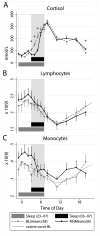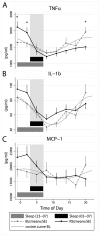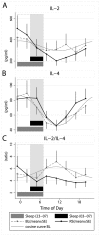Effects of sustained sleep restriction on mitogen-stimulated cytokines, chemokines and T helper 1/ T helper 2 balance in humans
- PMID: 24349251
- PMCID: PMC3859577
- DOI: 10.1371/journal.pone.0082291
Effects of sustained sleep restriction on mitogen-stimulated cytokines, chemokines and T helper 1/ T helper 2 balance in humans
Abstract
Background: Recent studies suggest that acute sleep deprivation disrupts cellular immune responses by shifting T helper (Th) cell activity towards a Th2 cytokine profile. Since little is known about more long-term effects, we investigated how five days of sleep restriction would affect pro-inflammatory, chemotactic, Th1- and Th2 cytokine secretion.
Methods: Nine healthy males participated in an experimental sleep protocol with two baseline sleep-wake cycles (sleep 23.00-07.00 h) followed by 5 days with restricted sleep (03.00-07.00 h). On the second baseline day and on the fifth day with restricted sleep, samples were drawn every third hour for determination of cytokines/chemokines (tumor necrosis factor alpha (TNF-α), interleukin (IL) -1β, IL-2, IL-4 and monocyte chemoattractant protein-1 (MCP-1)) after in vitro stimulation of whole blood samples with the mitogen phytohemagglutinin (PHA). Also leukocyte numbers, mononuclear cells and cortisol were analysed.
Results: 5-days of sleep restriction affected PHA-induced immune responses in several ways. There was a general decrease of IL-2 production (p<.05). A shift in Th1/Th2 cytokine balance was also evident, as determined by a decrease in IL2/IL4 ratio. No other main effects of restricted sleep were shown. Two significant interactions showed that restricted sleep resulted in increased TNF-α and MCP-1 in the late evening and early night hours (p's<.05). In addition, all variables varied across the 24 h day.
Conclusions: 5-days of sleep restriction is characterized by a shift towards Th2 activity (i.e. lower 1L-2/IL-4 ratio) which is similar to the effects of acute sleep deprivation and psychological stress. This may have implications for people suffering from conditions characterized by excessive Th2 activity like in allergic disease, such as asthma, for whom restricted sleep could have negative consequences.
Conflict of interest statement
Figures




References
-
- Kronholm E, Partonen T, Laatikainen T, Peltonen M, Härmä M et al. (2008) Trends in self-reported sleep duration and insomnia-related symptoms in Finland from 1972 to 2005: a comparative review and re-analysis of Finnish population samples. J Sleep Res 17: 54-62. doi:10.1111/j.1365-2869.2008.00627.x. PubMed: 18275555. - DOI - PubMed
Publication types
MeSH terms
Substances
LinkOut - more resources
Full Text Sources
Other Literature Sources
Research Materials
Miscellaneous

